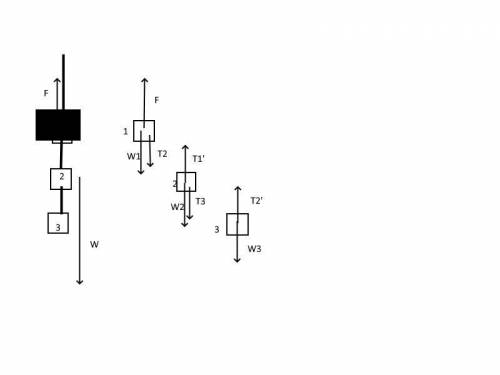
Physics, 28.02.2021 16:50 xandraeden32
A student suspends a chain consisting of three links, each of mass m 0.250 kg, from a light rope. The rope is attached to the top link of the chain, which does not swing. She pulls upward on the rope, so that the rope applies an upward force of 9.00 N to the chain.
a. Draw a free-body diagram for the entire chain, considered as a body, and one for each of the three links. (b) Use the diagrams of part (a) and Newton's laws to find (i) the acceleration of the chain, (ii) the force exerted by the
top link on the middle link, and (iii) the force exerted by the middle link on the bottom link. Treat the rope as massless.
1. There are four objects of interest in this problem: the chain as a whole and the three individual links. For each of these four objects, make a list of the external forces that act on it. Besides the force of gravity, your list should include only forces exerted by other objects that touch the object in question.
2. Some of the forces in your lists form actionâreaction pairs (one pair is the force of the top link on the middle link and the force of the middle link on the top link). Identify all such pairs.
3. Use your lists to help you draw a free-body diagram for each of the four objects. Choose the coordinate axes.
4. use your lists to decide how many unknowns there are in this problem. Which of these are target variables?
EXECUTE
5. Write a Newton's second law equation for each of the four objects, and write a Newton's third law equation for each actionâreaction pair. You should have at least as many equations as there are unknowns (see step 4). Do you?
6. Solve the equations for the target variables.
EVALUATE
7. You can check your results by substituting them back into the equations from step 6. This is especially important to do if you ended up with more equations in step 5 than you used in step 6.
8. Rank the force of the rope on the chain, the force of the top link on the middle link, and the force of the middle link on the bottom link in order from smallest to largest magnitude. Does this ranking make sense? Explain.
9. Repeat the problem for the case in which the upward force that the rope exerts on the chain is only 7.35 N. Is the ranking in step 8 the same? Does this make sense?

Answers: 1


Another question on Physics

Physics, 22.06.2019 06:00
What will a positive and a negative charge do if they are separated from each other?
Answers: 3


Physics, 22.06.2019 12:00
In a set amount of time, a battery supplies 25j of energy to an electric circuit that includes two different loads. one of the loads produces 10 j of heat energy during this time interval. how much heat energy is produced by the second load in this time? explain your answer
Answers: 3

Physics, 22.06.2019 12:40
Question part points submissions used suppose that 2 j of work is needed to stretch a spring from its natural length of 26 cm to a length of 36 cm. (a) how much work is needed to stretch the spring from 28 cm to 32 cm? (round your answer to two decimal places.)
Answers: 2
You know the right answer?
A student suspends a chain consisting of three links, each of mass m 0.250 kg, from a light rope. Th...
Questions


Biology, 29.11.2019 23:31

English, 29.11.2019 23:31

Physics, 29.11.2019 23:31






Social Studies, 29.11.2019 23:31






English, 29.11.2019 23:31





 - g (1)
- g (1)



